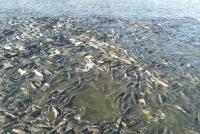基于多阶段特征提取的鱼类识别研究
摘要:
鱼类自动识别在海洋生态学、水产养殖等领域应用广泛。受光照变化、目标相似、遮挡及类别分布不均衡等因素影响,鱼类精准自动识别极具挑战性。提出了一种基于多阶段特征提取网络 (Multi-stage Feature Extraction Network, MF-Net) 模型进行鱼类识别。该模型首先对图片作弱增强预处理,以提高模型的计算效率;然后采用多阶段卷积特征提取策略,提升模型对鱼类细粒度特征的提取能力;最后通过标签平滑损失计算以缓解数据的不平衡性。为验证模型的性能,构建了一个500类、含32 768张图片的鱼类数据集,所建模型在该数据集上的准确率达到86.8%,优于现有的主流目标识别方法。利用公开的蝴蝶数据集对该模型进行泛化性能验证,多组消融实验进一步验证了所提算法的有效性。
Abstract:
Automatic fish recognition is widely used in the fields of marine ecology and aquaculture. Due to factors such as fluctuating illumination, overlapping instances and occlusion, accurate automatic identification of fish is extremely challenging. In order to solve these problems, this paper introduces an innovative Multi-stage Feature Extraction Network (MF-Net) model, which is predicated upon a multi-stage feature extraction paradigm for the domain of automatic fish recognition. The architecture of MF-Net commences with a subtle image enhancement preprocessing step, judiciously designed to augment the computational efficiency of the model. Then the deployment of a multi-stage convolutional feature extraction strategy is applied to improve the model's sensitivity towards the granular features of fish species. In an effort to mitigate issues arising from data imbalance, the model incorporates a long-tail loss computation strategy. To evaluate the efficacy of the proposed MF-Net, the study collects a comprehensive fish dataset encompassing 500 categories including 32 768 images. The proposed MF-Net demonstrated a remarkable accuracy of 86.8% on this dataset, thereby outperforming the recognition performance of the existing state-of-the-art target recognition algorithms. Furthermore, the model is tested on a publicly butterfly dataset to verify its generalization performance, and multiple ablation experiments further validate the effectiveness of the proposed algorithm.
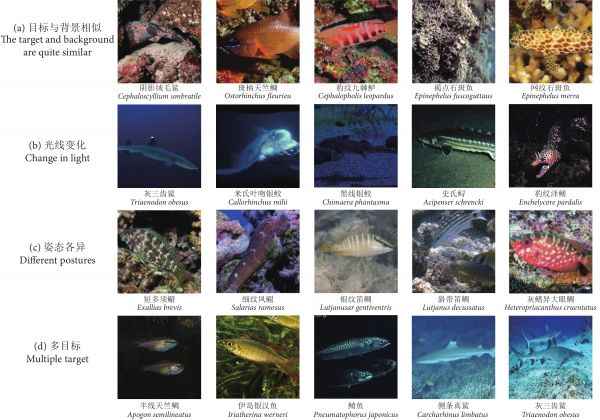
图 1 原始鱼类数据集特点
Figure 1. Characteristics of raw fish data
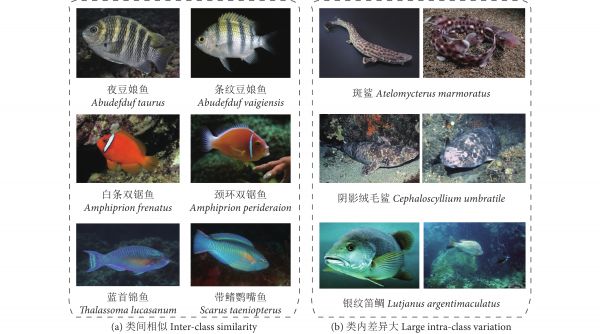
图 2 类间相似和类内差异
Figure 2. Subtle differences between species and dramatic changes among same species
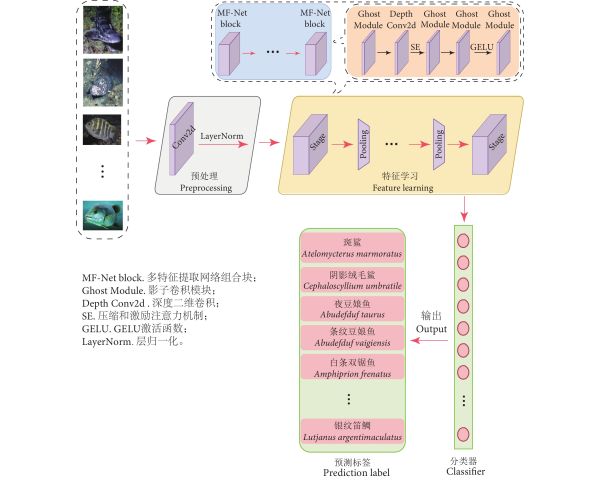
图 3 MF-Net模型结构
Figure 3. Structure of MF-Net
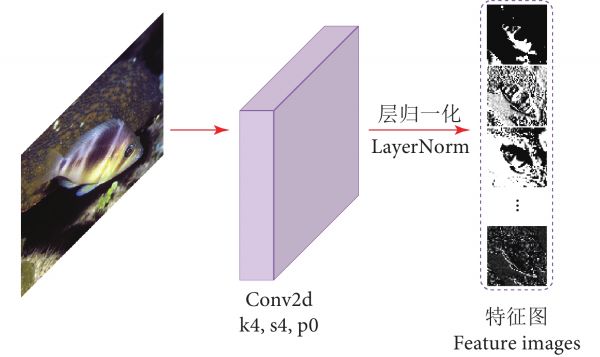
图 4 预处理模块
Figure 4. Pre-processing module
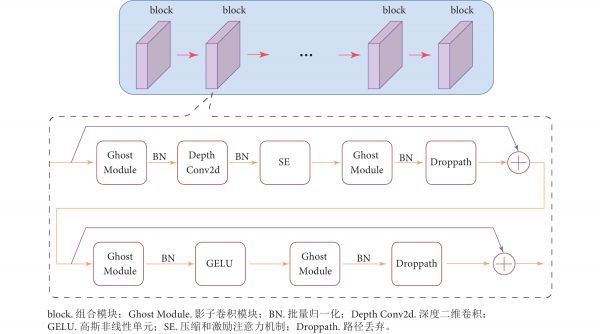
图 5 MF-Net block结构
Figure 5. Structure of MF-Net block

图 6 MF-Net模型不同预处理方式的识别结果
Figure 6. Recognition results based on different pro-processing strategies in proposed MF-Net
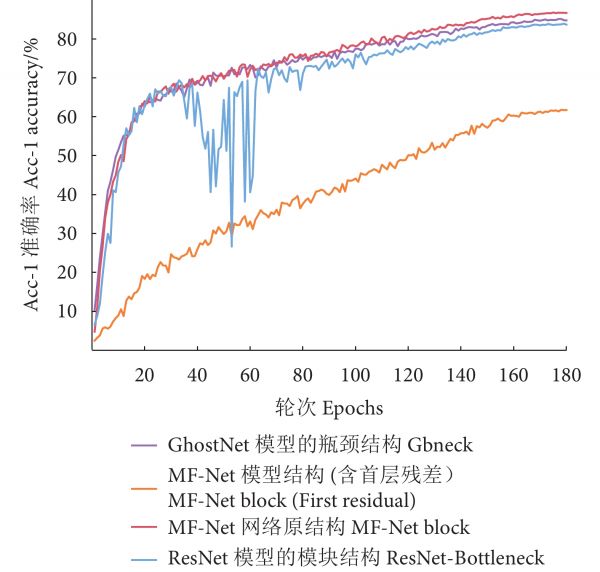
图 7 MF-Net 模型不同block结构的识别性能
Figure 7. Recognition results based on different block structures in proposed MF-Net
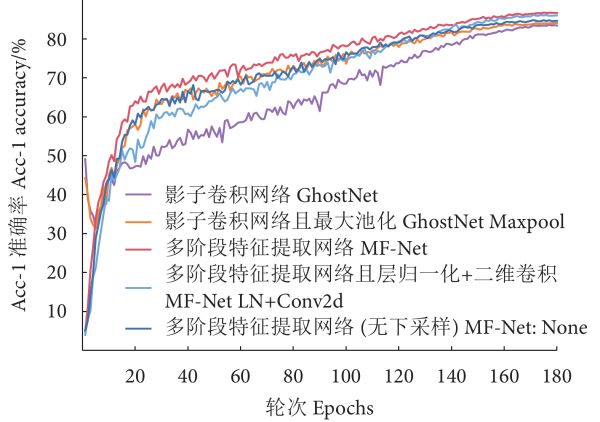
图 8 MF-Net模型中不同下采样策略
Figure 8. Recognition results based on different down sampling strategies in proposed MF-Net

图 9 基于不同损失函数的识别性能
Figure 9. Recognition results based on different loss functions in proposed MF-Net
表 1 主流识别模型性能对比
Table 1 Comparison of different generic recognition methods
模型Model浮点运算次数
Floating point operations per second/G参数量
Parameter quantity/MAcc-1准确率
Acc-1 accuracy/%召回率
Recall/%精确率
Precision/%F1分数
F1-score ResNet-504.13025.6082.6072.9778.090.724ResNet-50 (标签平滑
Label smoothing)4.13025.6085.1076.4580.270.761GhostNet0.1565.1883.3175.2178.850.746ConvNext15.40087.5084.2776.2079.620.759MF-Net1.74010.4086.8078.3781.800.781
表 2 蝴蝶数据集下不同长尾模型识别性能
Table 2 Comparison of accuracy with different long-tailed methods on butterfly dataset
模型ModelAcc-1 准确率
Acc-1 accuracy/%头部类别精度
Many-shot/%尾部类别精度
Few-shot/% DRC80.9087.2769.03BBN82.2088.0268.97ResNet-5080.9086.0966.66GhostNet82.2086.5568.33ConvNext82.7086.5868.09MF-Net83.8089.4072.55
表 3 鱼类数据集下不同长尾识别模型对比
Table 3 Comparison of different long-tailed methods on fish dataset
模型ModelAcc-1准确率
Acc-1 accuracy/%头部类别精度
Many-shot/%尾部类别性能
Few-shot/% BBN84.3789.4372.55DRC83.5988.7369.80MF-Net86.8090.1776.53
表 4 平衡鱼类数据集下不同识别模型损失对比
Table 4 Comparison of different recognition methods with different losses in balanced fish dataset
模型Model浮点运算次数
Floating point operations per second/G参数量
Parameter quantity/MAcc-1准确率
Acc-1 accuracy/%召回率
Recall/%F1分数
F1-score ResNet-50 (交叉熵 Cross entropy) 4.130 25.60 90.32 90.04 0.892 ConvNext (交叉熵Cross entropy) 15.400 87.50 91.85 90.07 0.901 GhostNet (交叉熵Cross entropy) 0.156 5.18 91.34 90.37 0.905 MF-Net (交叉熵Cross entropy) 1.740 10.40 94.50 94.19 0.943 ResNet-50 4.130 25.60 89.80 88.87 0.889 ConvNext 15.400 87.50 92.50 92.24 0.925 GhostNet 0.156 5.18 92.25 92.16 0.923 MF-Net 1.740 10.40 94.05 93.73 0.937 [1]
PRIMO A L. Ecology of marine fish larvae[M]//WALTER L F, ANABELA M A, LUCIANA B, et al. Encyclopedia of the UN sustainable development goals, life below water. New York: Springer Nature, 2021: 1-10.
[2]LI D L, WANG Z H, WU S Y, et al. Automatic recognition methods of fish feeding behavior in aquaculture: a review[J]. Aquaculture, 2020, 528: 735508. doi: 10.1016/j.aquaculture.2020.735508
[3] 麦广铭, 陈志劼, 王学锋, 等. 南海北部沿岸鱼类分类学多样性的空间格局[J]. 南方水产科学, 2022, 18(3): 38-47. doi: 10.12131/20210117 [4]CHEN W H, LIU J Y, ZHANG Y P, et al. Current status and accics of research on smart fishery in China: a literature review based on CNKI (2000−2022)[J]. Int J Environ Sustain Protect, 2023, 2(4): 24-32.
[5]HE K M, ZHANG X Y, REN S Q, et al. Deep residual learning for image recognition[C]//2016 IEEE Conference on Computer Vision and Pattern Recognition (CVPR), Las Vegas, NV, USA, 2016: 770-778. DOI: 10.1109/CVPR.2016.90.
[6]LIU Z, LI Y T, CAO Y, et al. Swin transformer: hierarchical vision transformer using shifted Windows[C]//2021 IEEE/CVF International Conference on Computer Vision (ICCV), Montreal, QC, Canada, 2021: n9992-10002. DOI: 10.1109/ICCV48922.2021.00986.
[7]ZHUANG P Q, WANG Y L, QIAO Y. Wildfish++: a comprehensive fish benchmark for multimedia research[J]. IEEE T Multimedia, 2021, 23: 3603-3617. doi: 10.1109/TMM.2020.3028482
[8]LIU Z H, JIA X J, XU X S. Study of shrimp recognition methods using smart networks[J]. Comput Electron Agric, 2019, 165: 104926. doi: 10.1016/j.compag.2019.104926
[9] 汪小旵, 武尧, 肖茂华, 等. 水产养殖中智能识别技术的研究进展[J]. 华南农业大学学报, 2023, 44(1): 24-33. doi: 10.7671/j.issn.1001-411X.202204013 [10]YANG X T, ZHANG S, LIU J T, et al. Deep learning for smart fish farming: applications, opportunities and challenges[J]. Rev Aquac, 2021, 13(1): 66-90. doi: 10.1111/raq.12464
[11]RUM S N M, NAWAWI F A Z. FishDeTec: a fish identification application using image recognition approach[J]. Int J Adv Comp Sci Appl, 2021, 12. DOI: 10.14569/IJACSA.2021.0120312.
[12] 李均鹏, 祝开艳, 杨澍. 基于迁移学习的复杂场景海洋鱼类识别方法[J]. 计算机应用与软件, 2019, 36(9): 168-174. doi: 10.3969/j.issn.1000-386x.2019.09.030 [13] 姚润璐, 桂詠雯, 黄秋桂. 基于机器视觉的淡水鱼品种识别[J]. 微型机与应用, 2017, 36(24): 37-39. [14]CHRISTENSEN J H, MOGENSEN L V, GALEAZZI R, et al. Detection, localization and classification of fish and fish species in poor conditions using convolutional neural networks[C]. 2018 IEEE/OES Autonomous Underwater Vehicle Workshop (AUV), Porto, Portugal, 2018: 1-6. DOI: 10.1109/AUV.2018.8729798.
[15]PRAMUNENDAR R A, WIBIRAMA S, SANTOSA P I. Fish classification based on underwater image interpolation and back-propagation neural network[C] 2019 5th International Conference on Science and Technology (ICST), Yogyakarta, Indonesia, 2019: 1-6.
[16]POUYANFAR S, TAO Y D, MOHAN A, et al. Dynamic sampling in convolutional neural networks for imbalanced data classification[C]//2018 IEEE Conference on Multimedia Information Processing and Retrieval (MIPR), Miami, FL, USA, 2018: 112-117. DOI: 10.1109/MIPR.2018.00027.
[17]KANG B Y, XIE S N, ROHRBACH M, et al. Decoupling representation and classifier for long-tailed recognition[J]. arXiv, 2020: 1910.09217v2. DOI: 10.48550/arXiv.1910.09217.
[18]ZHANG S Y, LI Z M, YAN S P, et al. Distribution alignment: a unified framework for long-tail visual recognition[C]//2021 IEEE/CVF Conference on Computer Vision and Pattern Recognition (CVPR), Nashville, TN, USA, 2021: 2361-2370. DOI: 10.1109/CVPR46437.2021.00239.
[19]CUI Y, JIA M L, LIN T Y, et al. Class-balanced loss based on effective number of samples[C/OL]//Proceedings of the IEEE/CVF Conference on Computer Vision and Pattern Recognition (CVPR). 2019: 9268-9277. [2023-11-10]. https://openaccess.thecvf.com/content_CVPR_2019/papers/Cui_Class-Balanced_Loss_Based_on_Effective_Number_of_Samples_CVPR_2019_paper.pdf.
[20]ZHOU B Y, CUI Q, WEI X S, et al. BBN: Bilateral-branch network with cumulative learning for long-tailed visual recognition[C]//2020 IEEE/CVF Conference on Computer Vision and Pattern Recognition (CVPR), Seattle, WA, USA, 2020: 9716-9725. DOI: 10.1109/CVPR42600.2020.00974.
[21]WANG W Q, ZHAO Z C, WANG P Y, et al. Attentive feature augmentation for long-tailed visual recognition[J]. IEEE T Circ Syst Vid Technol, 2022, 32(9): 5803-5816. doi: 10.1109/TCSVT.2022.3161427
[22]PANG S M, WANG W Y, ZHANG R Z, et al. Hierarchical block aggregation network for long-tailed visual recognition[J]. Neurocomputing, 2023, 549: 126463. doi: 10.1016/j.neucom.2023.126463
[23]HAN K, WANG Y H, TIAN Q, et al. GhostNet: more features from cheap operations[C]//2020 IEEE/CVF Conference on Computer Vision and Pattern Recognition (CVPR), Seattle, WA, USA, 2020: 1577-1586. DOI: 10.1109/CVPR42600.2020.00165.
[24]SZEGEDY C, VANHOUCKE V, IOFFE S, et al. Rethinking the inception architecture for computer vision[C]//2016 IEEE Conference on Computer Vision and Pattern Recognition (CVPR), Las Vegas, NV, USA, 2016: 2818-2826. DOI: 10.1109/CVPR.2016.308.
[25]PAN F Y, LI S K, AO X, et al. Warm up cold-start advertisements: improving ctr predictions via learning to learn ID embeddings[C]//SIGIR'19: Proceedings of the 42nd International ACM SIGIR Conference on Research and Development in Information Retrieval, July 2019: 695-704. DOI: 10.1145/3331184.3331268.
[26]LOSHCHILOV I, HUTTER F. SGDR: Stochastic gradient descent with warm restarts[J/OL]. arXiv, 2017: 1608.03983v5. https://arxiv.org/pdf/1608.03983.pdf.
[27]WOO S, DEBNATH S, HU R H, et al. Convnext v2: Co-designing and scaling convnets with masked autoencoders[C]//2023 IEEE/CVF Conference on Computer Vision and Pattern Recognition (CVPR), Vancouver, BC, Canada, 2023: n16133-16142. DOI: 10.1109/CVPR52729.2023.01548.
[28]XU C D, CAI R J, XIE Y H, et al. Fine-grained butterfly recognition via peer learning network with distribution-aware penalty mechanism[J]. Animals, 2022, 12(20): 2884. doi: 10.3390/ani12202884
相关知识
基于多阶段特征提取的鱼类识别研究
基于双流特征提取的哺乳动物行为识别方法及模型
基于心率变异性的情绪识别研究
基于深度学习的水下鱼类检测与种类识别算法研究
宠物声音识别与理解研究.pptx
【鱼类识别】 VCG
基于深度学习的鸟类声音识别的研究与应用
基于改进AlexNet的鱼类识别算法
音乐情感识别算法研究
基于YOLO特征检测模型的非法溜宠物识别
网址: 基于多阶段特征提取的鱼类识别研究 https://www.mcbbbk.com/newsview709716.html
| 上一篇: 常见鱼病诊断 |
下一篇: YOLO |
推荐分享

- 1养玉米蛇的危害 28694
- 2狗交配为什么会锁住?从狗狗生 7180
- 3我的狗老公李淑敏33——如何 6236
- 4豆柴犬为什么不建议养?可爱的 4637
- 5南京宠物粮食薄荷饼宠物食品包 4563
- 6中国境内禁养的十大鸟种,你知 4429
- 7湖南隆飞尔动物药业有限公司宠 4259
- 8自制狗狗辅食:棉花面纱犬的美 4257
- 9家养水獭多少钱一只正常 4212
- 10广州哪里卖宠物猫狗的选择性多 4122



